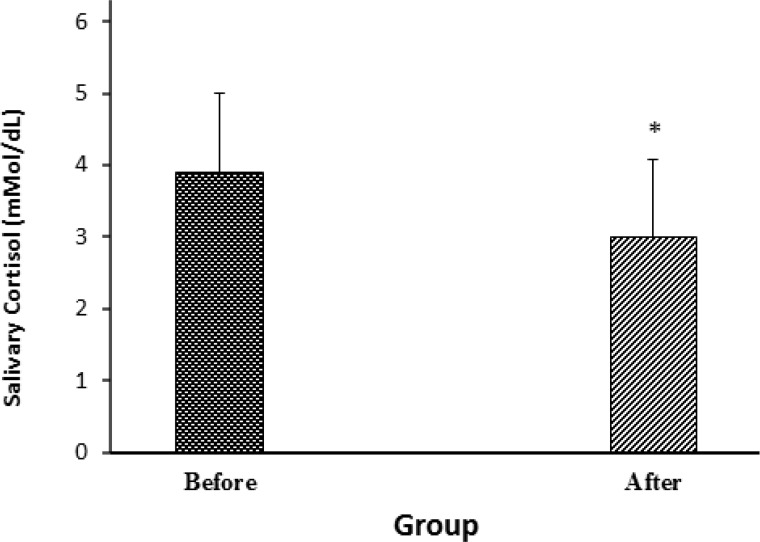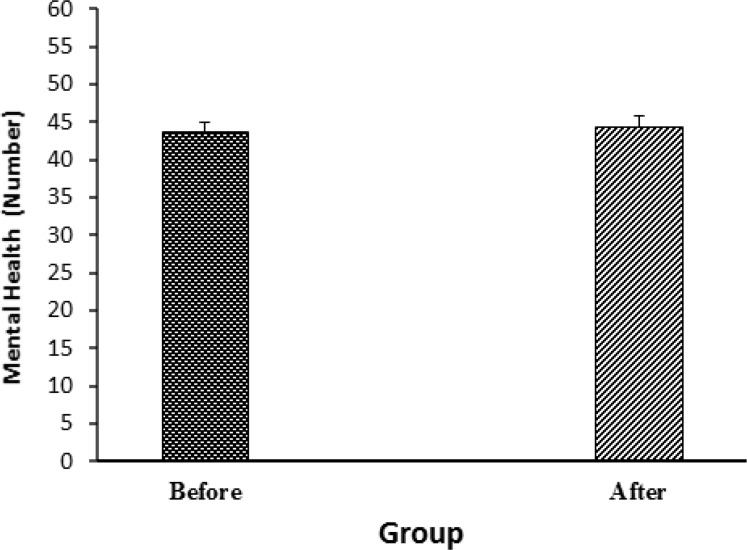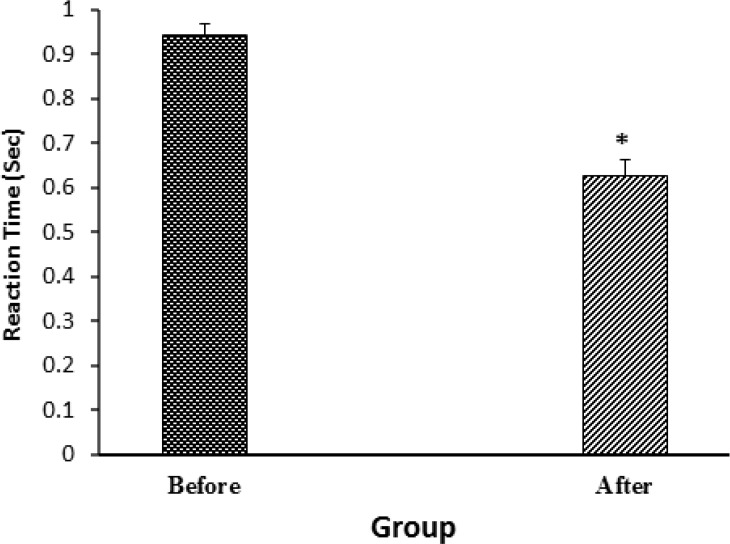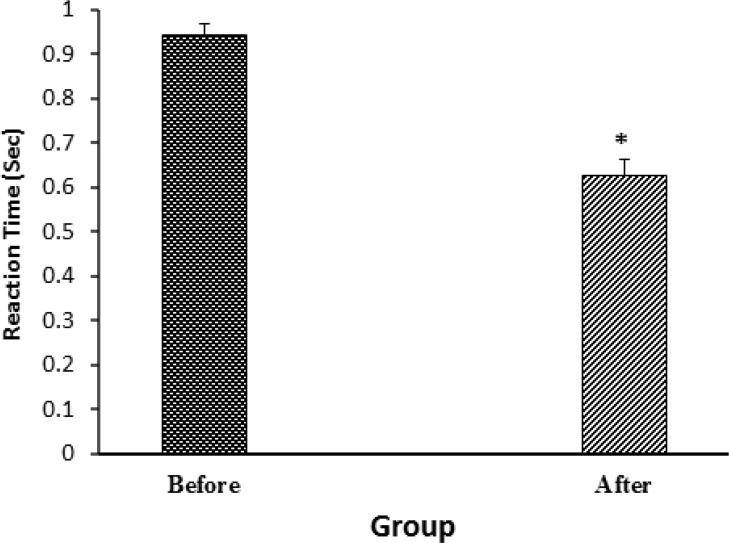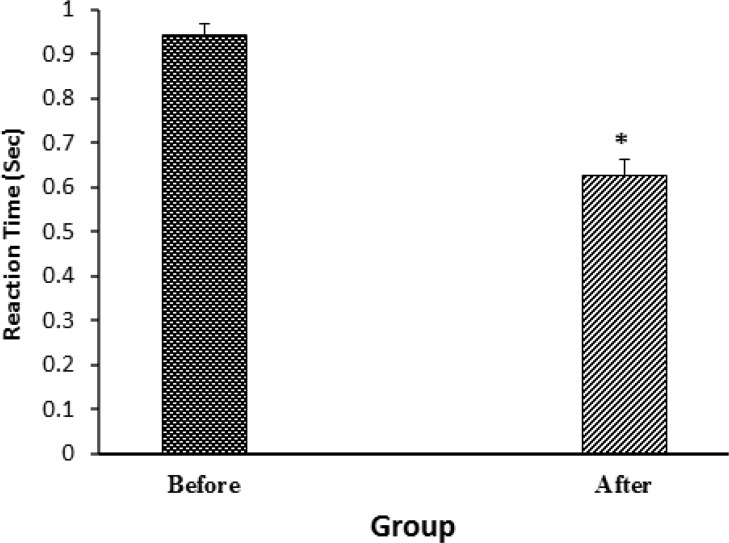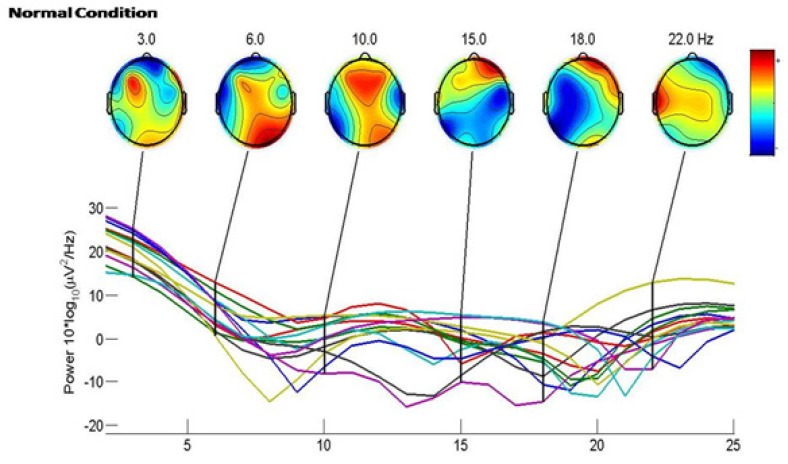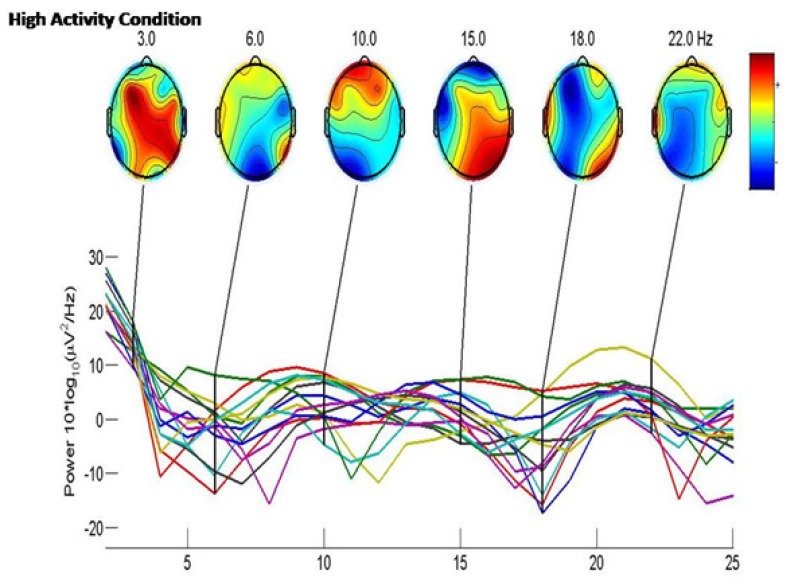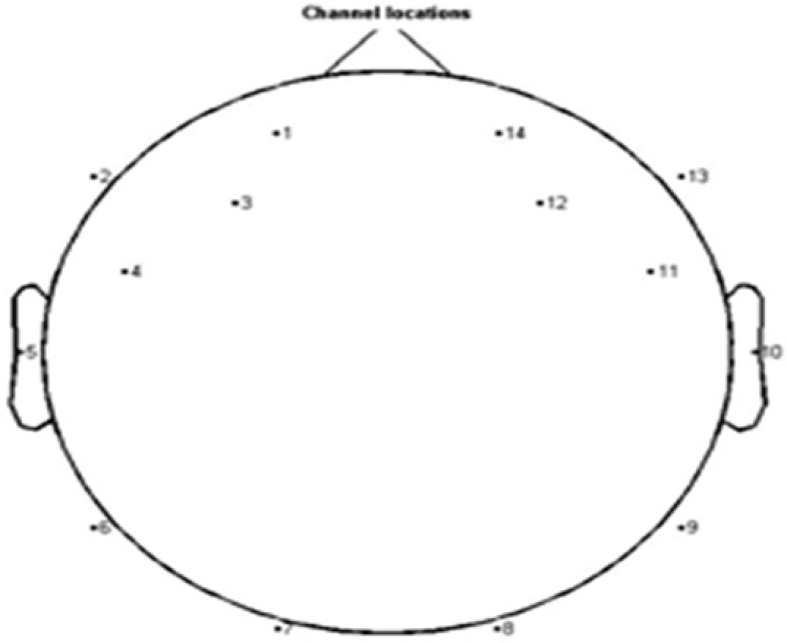Abstract
Introduction:
Computer games have attracted remarkable attentions in general publics with different cultures and their effects are subject of research by cognitive neuroscientists. In the present study, possible effects of the game Fifa 2015 on cognitive performance, hormonal levels, and electroencephalographic (EEG) signals were evaluated in young male volunteers.
Methods:
Thirty two subjects aged 20 years on average participated mutually in playing computer game Fifa 2015. Identification information and general knowledge about the game were collected. Saliva samples from the contestants were obtained before and after the competition. Perceptive and cognitive performance including the general cognitive health, response delay, attention maintenance, and mental fatigue were measured using PASAT test. EEG were recorded during the play using EEG device and analyzed later using QEEG. Simultaneously, the players’ behavior were recorded using a video camera. Saliva cortisol levels were assessed by ELISA kit. Data were analyzed by SPSS program.
Results:
The impact of playing computer games on cortisol concentration of saliva before and after the game showed that the amount of saliva plasma after playing the game has dropped significantly. Also the impact of playing computer games on mental health, before and after the game indicated that the number of correct answers has not changed significantly. This indicates that sustained attention has increased in participants after the game in comparison with before that. Also it is shown that mental fatigue measured by PASAT test, did not changed significantly after the game in comparison to before that. The impact of game on changes in brain waves showed that the subjects in high activity state during playing the game had higher power of the EEG signals in most of the channels in lower frequency bands in compared to normal state.
Discussion:
The present study showed that computer games can positively affect the stress system and the perceptual-cognitive system. Even though this impact was not significant in most cases, the changes in cognitive and hormonal test and also in brain waves were visible. Hence, due to the importance of this matter, it is necessary to create control systems in selecting the types of games for playing.
Keywords: Cognitive, EEG, Saliva, Cortisol, Video Games
1. Introduction
Computer games are a common and prevalent cultural issue in all languages. These games, similar to other human-made instruments and modern technology are made as a response to what is appealing to the human and have important role in daily life’s skills (Thirunarayanan & Vilchez, 2012). The action game FPS (First-person shooter) for instance, on one hand leads to boosting brain function in response speed, concentration, attention, spatial cognition and life skills (Bejjanki et al., 2014; Feng, Spence, & Pratt, 2007) and on the other hand, exciting, stressful and scary games have negative effects on the cognition and right processes of the nervous system. Another harmful effect is on people’s thoughts, their lifestyle, sometimes happening so subtly that they don’t notice but does irreparable damages (Gray, Braver, & Raichle, 2002; Tamamiya, Matsuda, & Hiraki, 2014).
At the thinking process of people, different parts of brain structure, including prefrontal area are involved. The thinking process includes issues such as creative thinking, decision-making, aesthetics, judgment, and problem solving (Kringelbach & Rolls, 2004; Rosen-bloom, Schmahmann, & Price, 2012). Targeted computer games can promote a healthy lifestyle and life skills such as confidence, strengthen the spirit of partnership and cooperation, develop human emotions, improve physical and mental health, improve the adaptability of the person with themselves, others and their environment of life (Thirunarayanan & Vilchez, 2012). Browsing into the frontal cortex with other parts of the brain, including the neo-cortex, cerebellum system, basal complexes and limbic system approves the theories in relation to cognitive-perceptual processes and the decision-making system and specifies a neuroanatomic model of the decision-making chain in the brain (Krawczyk, 2012; Kringelbach & Rolls, 2004).
The brain of a hyperactive child always distracts while doing a task and has a deficiency of attention. The clinical demonstration of the condition of these children includes carelessness, negligence and disregarding details, difficulty in social relationships and low self-esteem (Lofthouse, Arnold, & Hurt, 2012; Rosenbloom, et al., 2012). Over 10 years of research on the impact of computer games on the human brain indicates that puzzle games like Tetris can increase the effectiveness of parts of the brain such as problem solving, decision making and processing. The impact of computer games on the human brain has long been studied. One of the most notable studies in this field was conducted in 1992 by a neurologist at the University of California, Richard Higher. He studied the impact of computer games on the users’ brains. The impact of Tetris game shows how learning to play a game like Tetris can affect the brain function (to increase spatial skills) and a game like FPS improves functions such as selective spatial attention and spatial perceptive analysis in an equal way (Foroozandeh & Mahdieh, 2014; Masson, Bub, & Lalonde, 2011).
Showing faces with different emotional states lead to intense activity in the amygdala. Including the amygdala responses to emotional behavior and stimulating changes related to the physiology of the human nervous system. Scientists have also proven that amygdala response to aggressive faces is stronger than responses to happy faces (Davis & Granger, 2009; Feinstein, Adolphs, Damasio, & Tranel, 2011; Nater & Rohleder, 2009). On the other hand, scientists have shown that computer games can lead to changes in stress factors and result in changes in brain function. Several studies have indicated that chronic stress due to continuous stimulation of the hypothalamic-pituitary-adrenal stress system (Hypothalamus-Pituitary-Adrenal Axis, HPA) causes chronic sustained increase in plasma density of cortisol in the blood (S. Lupien et al., 1999; S. J. Lupien et al., 1998; Wolf et al., 2001). Due to this matter, continuous stimulation of these receptors occurs in the areas of the brain with high cortisol receptor (McEwen & Morrison, 2013). This constant stimulation aids the activation of glutamate receptors in the brain and the system stimulates receptors, N-Methyl-D-Aspartate, NMDA and so motivates the excessive entrance of calcium ions into cells of targeted tissue (Lofthouse et al., 2012).
On the other hand, increasing the time of stimulation and the excessive entrance of calcium ions into the cells through the NMDA receptors, the activity of the next group of enzymes have more role in the process of programmed cell death (Apoptosis) (S. J. Lupien & Lepage, 2001). For this reason, most of the damage of chronic stress relates to areas of the brain which have a lot of glucocorticoid receptors. Research has shown that the hippocampus as an important structure in the brain is involved in the memory and the main site of expression and activity of these receptors is the hippocampus (S. J. Lupien et al., 2005). Previous extensive research suggests that short-term stress with rapid increase in cortisol concentration results in increase in cognitive abilities associated with the hippocampus such as memory (its types). The research indicates that memory loss occurs in people with chronic stress conditions (apart from the stress type) (S. J. Lupien & Lepage, 2001; McEwen & Morrison, 2013). Thus it seems that increase of the stress time (chronic stress) and imposing several types of stress simultaneously not only leads to memory loss, but more importantly leads to disorders in brain processes related to memory such as decision-making, responding, the ability of integrating various sensory inputs and different types of memory (Wolkowitz, Lupien, Bigler, Levin, & Canick, 2004). Research has shown that current computer games are able to affect a wide variety of cognitive-perceptive functions in the users. These changes can be due to functional changes in different brain parts. Researchers have used the brain wave recorder machine to study the various functions of the brain during games recorded (Minchev, Dukov, & Georgiev, 2009; Sepúlveda, Alonso, Guevara, & González, 2014).
While recording process, the neurons of different areas of brain are created through displacement ions involved in neuronal function. Cerebral cortex is the center of high mental processes, the place of registration of feelings, starting intentional actions, making decisions and formulating plans (Gray et al., 2002). Electrical activity of neurons in the brain causes the formation of brain electrical activity called brain waves. Brain waves have different types and functionality and are divided into different types depending on the frequency (delta wave, theta wave, alpha wave, wave SMR, wave, beta, gamma wave). The performance and activity level of each of these waves can vary in different circumstances. The amount of changes differ by the type of brain function wave (Başar, Başar-Eroglu, Karakaş, & Schürmann, 2001; Sepúlveda et al., 2014). Using the recognition software PASAT, changes in cognitive function including attention, mental fatigue, and general health of the volunteers was examined before and after the game (Tombaugh, 2006). The purpose of this study is to study and analyze the changes in cognitive and hormonal changes created in brain waves while playing the game of Fifa 2015 in young male volunteers so that by analyzing these changes before, during, and after the game we can reach a proper approach as to how computer games affect different functions of people.
2. Methods
32 university student volunteers with an average age of 20 years enrolled in the project. The questionnaire included personal details and questions about their favorite game, type of games, time of day to play, and many other questions. The volunteers participated in a double tournament game of Fifa 2015 football match. The game was played as a single knockout and elitism index showed to improve the quality of the results. Before and after the game, saliva samples were collected from all the participants in the study in Falcon tubes of 10 mL volume and was maintained at −20°C. On the day of experiment, first the samples were melted at room temperature and after centrifuging with round 3000 for 5 minutes, 20 microliters of each sample was separated for testing. Then, Cortisol ELISA kit was employed for the measurement of human salivary cortisol (Cortisol ELISA KIT, Diagnostics Biochem Canada Inc, dbc).
The PASAT test was used to assess cognitive performance of the subjects. PASAT software was used to assess cognitive perceptual activity of the players before and after the game (Tombaugh, 2006). In this test, 61 numbers between 1 and 9 are presented randomly in time intervals of 3 seconds. The testee should add every two consecutive end numbers up together and tells their number before presenting a new number. For example, if the numbers are 2 and 6 respectively, to respond correctly they should say number 8. Each testee would give some correct answers in every test which (the accuracy of the response) would be compared to each other for every test before and after it. The average response time (response speed), the longest chain of correct answers (sustained attention) and the longest chain of incorrect answers (mental fatigue) are also examined in this study.
Moreover, during the game, the participants’ brain waves that were recorded using EEG machine from Emotive Company in wireless way were examined. During the game from beginning to end, the changes in brainwaves were recorded using quantitative electroencephalography (QEEG) by placing 14 electrodes on the volunteers’ heads (based on quantitative evaluation index). They were also displayed based on intensity of brainwaves activity in two-dimensional and three-dimensional maps as different colors using Brain Mapping software. PASAT data analysis and the amount of cortisol level were analyzed by SPSS and changes of brain waves were evaluated by QEEG during the game.
The data were expressed as mean and standard deviation (Mean±SEM). Paired t-Test was used to determine the significance of the within-group differences. P<0.05 was considered statistically significant.
3. Results
3.1. The impact of Fifa 2015 computer game on salivary cortisol concentration before and after playing the game
In this section of the study, the levels of cortisol in collected saliva samples were analyzed using ELISA. The results showed that the plasma levels in saliva after a Fifa 2015 football game has significantly decreased after the game in comparison with before that (P<0.05) (Figure 1).
Figure 1.
Salivary cortisol concentration changes in the participants before and after the football computer game Fifa 2015 shows a significant decrease in cortisol concentration after the game in comparison with before the game (P<0.05).
3.2. The impact of Fifa 2015 computer game on mental health (number of correct answers) in PASAT test, before and after the game
The results showed that the number of correct answers has not changed significantly before and after the game and so the participants’ mental health has not undergone significant changes (Figure 2).
Figure 2.
The number of correct answers (Mental health) provided by the participants before and after the football computer game Fifa 2015 shows no significant changes.
3.3. The impact of Fifa 2015 computer game on response time
The results of PASAT test showed that the participants’ response time after the game has increased significantly in comparison with before the game (P<0.05) (Figure 3).
Figure 3.
The response speed in participants after computer football computer games Fifa 2015 increases significantly in comparison with before the game (P<0.05).
3.4. The impact of Fifa 2015 computer game on sustained attention
As mentioned, the longest chain of correct answers in PASAT test are considered as a measure of sustained attention. Results showed that sustained attention has increased after the game in comparison with before that, however, it has not been statistically significant (Figure 4).
Figure 4.
Sustained attention (the longest correct answer chain) in the participants after a football computer game Fifa 2015 increases in comparison with before the game, but this change is not statistically significant.
3.5. The impact of Fifa 2015 computer game on mental fatigue
The longest chain of wrong answers in PASAT test is considered as a symbol of mental fatigue. Results showed that there has been no significant changes in this parameter after the game in comparison with before that (Figure 5).
Figure 5.
Mental fatigue (the longest wrong answer chain) in the participants, after a football computer game Fifa 2015 does not change significantly in comparison with before the game.
3.6. The impact of Fifa 2015 computer game on changes in the brain waves
The impact of the game on brain waves changes was also evaluated. The EEG signals were collected during playing the game (FIFA 2015) using EMOTIV system in 14 channels. The signals were then analyzed using the EEGLAB. The period of 2s in the normal condition (Figure 6) and the same period during the high activity condition (Figure 7) were analyzed. These conditions have been taken from the movies taken during playing the game based on the face of the subjects. As it is shown in the figure 6 and 7, the power of the signal has been increased in most of the electrodes in lower bands (3Hz) during the high activity compared to the time of starting the game. This can be due to the high activity during playing the game. This increased of power can be also seen in occipital electrodes in higher frequency bands (15Hz). In contrast, the power of the signal has been decreased in occipital lobe (in 6 and 10Hz) and in frontal lobe (in 15 and 18Hz) (Figure 6,7).
Figure 6.
Brain mapping in normal condition during playing the computer game.
Figure 7.
Brain mapping in the high activity condition during playing the computer game.
Figure 8.
The location of electrodes in Emotive recording system.
The results have been summarized in Table 1. The average and the standard deviation of the power for the two conditions have been reported in this table. The average and the standard deviation of the power for the two conditions have been reported in this table for 14 recorded channels using the Emotive system.
Table 1.
The average and the standard deviation of the power for the two conditions have been reported in this table for 14 channels recorded using the Emotive system.
| Channel | 1 | 2 | 3 | 4 | 5 | 6 | 7 | 8 | 9 | 10 | 11 | 12 | 13 | 14 | Sum Channel |
|---|---|---|---|---|---|---|---|---|---|---|---|---|---|---|---|
| Normal condition player 1 | −20.1 | −16.6 | −4.44 | −16 | 1.44 | −24.9 | −11.2 | 11.7 | 13.7 | 2.35 | −27.4 | −14.6 | −3.7 | −8.03 | −8.41286 |
| High activity condition player 1 | −9.34 | −51.1 | −6.82 | −1.68 | −1.88 | −26.4 | −7.61 | 6.01 | −6.22 | −4.35 | −7.9 | −8.47 | −52.8 | 6.42 | −12.2957 |
| Normal condition player 2 | 3.95 | −7.44 | 12.9 | −5.01 | 4.34 | −15.9 | −4.24 | 15.5 | 2.97 | 6.7 | −30.9 | −5.31 | −4.01 | 1.09 | −1.81143 |
| High activity condition player 2 | −12 | −23.3 | −3.67 | −16.4 | −3.15 | 52.2 | 0.382 | 4.88 | 9.09 | −2.88 | −0.306 | −16.6 | −18 | −5.18 | −2.49529 |
| Normal condition player 3 | 6.33 | −15.9 | 40.5 | 0.587 | −3.71 | −14.17 | 10.8 | 7.79 | 16.1 | 17 | −4.48 | 13.5 | 26.1 | −8.83 | 6.544071 |
| High activity condition player 3 | 10.9 | 10.3 | 22.7 | 16.5 | 5.95 | 26.7 | 23.7 | 19.2 | 59.2 | 13.2 | 20 | 10.6 | 23.6 | 4.38 | 19.06643 |
| Normal condition player 4 | 8.45 | −4.08 | 39.5 | 6.48 | 6.5 | −5.9 | 16.6 | 14.6 | 18.7 | 23.4 | 1.5 | 9.18 | 25 | −9.94 | 10.71357 |
| High activity condition player 4 | 7.45 | −15.1 | 42.7 | 4.75 | −2.66 | 0.463 | 12 | 6.68 | 32.3 | 7.19 | 26.2 | 7.96 | 3.66 | 2.06 | 9.6895 |
| Sum normal condition | −0.3425 | −11.005 | 22.115 | −3.48575 | 2.1425 | −15.2175 | 2.99 | 12.3975 | 12.8675 | 12.3625 | −15.32 | 0.6925 | 10.8475 | −6.4275 | |
| Sum high activity condition | −0.7475 | −19.8 | 13.7275 | 0.7925 | −0.435 | 13.24075 | 7.118 | 9.1925 | 23.5925 | 3.29 | 9.4985 | −1.6275 | −10.885 | 1.92 | |
| Sum | −0.545 | −15.4025 | 17.92125 | −1.34663 | 0.85375 | −0.98838 | 5.054 | 10.795 | 18.23 | 7.82625 | −2.91075 | −0.4675 | −0.01875 | −2.25375 |
4. Discussion
Depending on the type of game (action-adventure, horror, strategy, entertaining), computer games utilizes dynamic images and exciting sounds to present a thrilling world to people eager for excitement and this appeal is what takes them to a whimsical world where they can think of themselves as heroes and centers of the world around them (Bartholow, Bushman, & Sestir, 2006; Feng et al., 2007; Masson et al., 2011; Tamamiya et al., 2014). Studies in this field indicate that playing action video games (VGP) type can affect the visual short-term memory, spatial cognition, multitasking and some aspects of executive functioning (Boot, Kramer, Simons, Fabiani, & Gratton, 2008; Mishra, Bavelier, & Gazzaley, 2012). In the present study we used Fifa 2015 game. A comparison of the amount of cortisol before and after the game in players of Fifa 2015 showed a statistically significant decrease in cortisol levels after the game in comparison with before that (Figure 1). Investigations showed that the initial stress increases mental abilities such as attention and processing speed and ability for decision-making, unlike chronic stress that impairs mental ability (S. J. Lupien & Lepage, 2001; McEwen & Morrison, 2013).
On the other hand, short-term stress leads to a sense of competition and excitement associated with the complex amygdala function of the emotion. On the other hand, the central amygdala as the brain stem controller, controls emotional behavior and physiological responses such as neuroendocrine and autonomic responses such as the HPA axis are activated before the game and plasma cortisol concentration goes up. The activity increases the amount of saliva cortisol. Studies have shown that stress hormones particularly cortisol can reduce the inter-cellular connection in the forebrain, mainly prefrontal cortex, in long term and also hippocampus and reduces the decision-making skill and short-term memory. This decrease of activity leads to disruptions in decision-making system and amygdala activity and increases the probability of anti-social behavior such as fear, anger and other abnormalities (Davis & Granger, 2009; Nater & Rohleder, 2009). Hence, measuring the amount of this hormone can show the activity level of system resulting from different kinds of games. In the present study, the increase in saliva cortisol concentration before the game is probably related to the stress-emotion system of the players before the game (Feinstein et al., 2011; Nater & Rohleder, 2009) such that the amount of cortisol after the end of the game is reduced significantly (Figure 1).
Functional and structural changes in the human amygdala have been reported in a wide variety of conditions which include mental disorders, stress disorder, anxiety disorder (PTSD, fear and paranoia), depression, schizophrenia, and autism. Studies have also shown that stress system activity causes sympathetic (or parasympathetic) responses in the person (Feinstein et al., 2011; Nater & Rohleder, 2009). One of these responses is the increase in the secretion of the enzyme in saliva (salivary alpha-amylase). This reaction occurs rapidly and its effect are showed within a few minutes. Therefore, the increased concentration of salivary alpha-amylase enzyme is known as a non-invasive biological index for measuring the activity of the sympathetic nervous system. This enzyme is also a valuable tool for the study of stress as studies have shown that the levels of these enzymes vary in response to acute and chronic stress. This increase occurs as the adrenergic system activity increases in the salivary glands (Davis & Granger, 2009; S. J. Lupien et al., 2005).
PASAT test is the test that is frequently used by “neuropsychologists” to assess patients’ consciousness processing. This is a tool to test the “immediate memory” and “attention” in which the “stimulus” is presented through visual or auditory ways. PASAT test was first used in 1974 by Gronwall and Sampson simultaneously with the publication of the research on the effects of brain damage on the speed of information processing in the brain (Tombaugh, 2006). PASAT test was designed to assess the effects of brain damage on cognitive function of the brain in patients with a wide variety of neurological - psychological syndromes. The impact of computer games on public mental health (number of correct answers in PASAT test) before and after playing showed that the number of correct answers before and after the game does not convey a significant change, and therefore people’s mental health during this game did not undergo specific and significant changes (Figure 2).
Public mental health is one of the symptoms of correct mental functioning in people and reflects the correct relationship between various parts of the nervous system associated with cognitive functions such as memory, learning, and the fluent verbal ability. Since these relations are crucial for a nervous system to function in coordination with each other in a programmed manner, any factor which may disrupt or reduce this relationship, can affect the output of the nervous system (here the correct answers to questions) (McEwen & Morrison, 2013; Tombaugh, 2006). The influence of computer games on the response speed from PASAT test in this section shows that the response speed in people has increased significantly after the game in comparison with before the game (Figure 3).
In addition to the role of emotion, scientists consider amygdala as a part of the brain that is involved in regulating a variety of cognitive functions such as attention, perception and explicit memory. The cognitive functions mentioned above are mediated by amygdala processing of the external stimulation of the mediate emotions, then the output of the amygdala leads to the release of hormones in blood through the stimulation of hippocampus, frontal cortex and finally the hypothalamus and the activation of hypothalamic-pituitary -adrenal stress axis. These hormones move toward the brain and attach to the neurons in the amygdala and finally connect with the hippocampus and improve the explicit memory (Hanif, 2013; LaBar & Cabeza, 2006; Smeets, Otgaar, Candel, & Wolf, 2008).
In the study also the response speed increases as it is closely connected to short-term memory. The impact of computer games on the sustained attention that is depicted by the longest chain of correct answers in PASAT test is also studied. Results in this section shows that sustained attention at individuals after the game has increased in comparison with before the game, but this was not a statistically significant change (Figure 4). Making a decision is the result of an active memory to perform brain processing and processes that are used to maintain and manipulate information in short term. This memory activates for a short time, focuses our attention on a specific topic, removes irrelevant information and leads us to a decision. Active memory deficiency causes disruption in efficiency, learning calculations and solving complex problems. Active memory is also essential to control attention (Boot et al., 2008; Tang & Posner, 2009).
The results of the latest PASAT test that used the longest chain of wrong answers as a symbol of mental fatigue shows that there was not a significant change in people after the game in comparison with before the game (Figure 5). Increasing the number of wrong answers does not mean that the brain was not able to collect exact and acceptable answers (Tombaugh, 2006). One of the explanations for this inability could be that due to the existence of underlying stresses, the ability of the brain based on hippocampus function reduces (S. J. Lupien & Lepage, 2001; McEwen, de Leon, Lupien, & Meaney, 1999). In previous research it has been determined that being at the presence of stress weakens the ability to make decisions in animal or human models and disrupt different types of memory (S. J. Lupien, et al., 2005; Maheu, Joober, & Lupien, 2005). Therefore, it can be stated that in the present study, mental fatigue after the game does not have a negative effect on brain function (Figure 5).
The impact of the game on brain waves changes was evaluated. The results showed that during high activity when the subjects played games, the power of the EEG signals in most of the channels in lower frequency bands increased. The high activity during playing the game decreased the power of the EEG in lower frequencies in occipital lobe and in higher frequencies in frontal electrodes (Figure 6,7) (Table 1).
Acknowledgments
We thank Daj Company as the sponsor of the Neuro-game designs in the third congress of the basic and clinical neuroscience as well as the Student Committee members for their cooperation in the third congress of basic and clinical neuroscience.
References
- Bartholow B. D., Bushman B. J., Sestir M. A. (2006). Chronic violent video game exposure and desensitization to violence: Behavioral and event-related brain potential data. Journal of Experimental Social Psychology, 42(4), 532– 539. [Google Scholar]
- Başar E., Başar-Eroglu C., Karakaş S., Schürmann M. (2001). Gamma, alpha, delta, and theta oscillations govern cognitive processes. International Journal of Psychophysiology, 39(2), 241– 248. [DOI] [PubMed] [Google Scholar]
- Bejjanki V. R., Zhang R., Li R., Pouget A., Green C. S., Lu Z. L., Bavelier D. (2014). Action video game play facilitates the development of better perceptual templates. Proceedings of the National Academy of Sciences, 111(47), 16961– 16966. [DOI] [PMC free article] [PubMed] [Google Scholar]
- Boot W. R., Kramer A. F., Simons D. J., Fabiani M., Gratton G. (2008). The effects of video game playing on attention, memeory, and executive control. Acta Psychologica, 129(3), 387– 398. [DOI] [PubMed] [Google Scholar]
- Davis E. P., Granger D. A. (2009). Developmental differences in infant salivary alpha-amylase and cortisol responses to stress. Psychoneuroendocrinology, 34(6), 795– 804. [DOI] [PMC free article] [PubMed] [Google Scholar]
- Feinstein J. S., Adolphs R., Damasio A., Tranel D. (2011). The human amygdala and the induction and experience of fear. Current Biology, 21(1), 34– 38. [DOI] [PMC free article] [PubMed] [Google Scholar]
- Feng J., Spence I., Pratt J. (2007). Playing an action video game reduces gender differences in spatial cognition. Psychological Science, 18(10), 850– 855. [DOI] [PubMed] [Google Scholar]
- Foroozandeh E., Mahdieh M. (2014). Effect of Play Therapy on Visual Memory in ADHD Children. International Journal of Sport Studies, 4(8), 1005– 1009. [Google Scholar]
- Gray J. R., Braver T. S., Raichle M. E. (2002). Integration of emotion and cognition in the lateral prefrontal cortex. Proceedings of the National Academy of Sciences, 99(6), 4115– 4120. [DOI] [PMC free article] [PubMed] [Google Scholar]
- Hanif A. (2013). Attentional modulation of cognition and emotion: Evidence from measures of mood, self-regulation, and functional connectivity within the cerebral cortex (Doctoral dissertation). The University of Guelph; Canada. [Google Scholar]
- Krawczyk D. C. (2012). The cognition and neuroscience of relational reasoning. Brain Research, 1428, 13– 23. [DOI] [PubMed] [Google Scholar]
- Kringelbach M. L., Rolls E. T. (2004). The functional neuroanatomy of the human orbitofrontal cortex: evidence from neuroimaging and neuropsychology. Progress in Neurobiology, 72(5), 341– 372. [DOI] [PubMed] [Google Scholar]
- LaBar K. S., Cabeza R. (2006). Cognitive neuroscience of emotional memory. Nature Reviews Neuroscience, 7(1), 54– 64. [DOI] [PubMed] [Google Scholar]
- Lofthouse N., Arnold L. E., Hurt E. (2012). Current status of neurofeedback for attention-deficit/hyperactivity disorder. Current Psychiatry Reports, 14(5), 536– 542. [DOI] [PubMed] [Google Scholar]
- Lupien S. J., Nair N. P. V., Briere S., Maheu F., Tu M. T., Lemay M., et al. (1999). Increased cortisol levels and impaired cogniation in human aging: implication for depression and dementia in later life. Reviews in the Neurosciences, 10(2), 117– 140. [DOI] [PubMed] [Google Scholar]
- Lupien S. J., de Leon M., De Santi S., Convit A., Tarshish C., Nair N. P. V., et al. (1998). Cortisol levels during human aging predict hippocampal atrophy and memory deficits. Nature & Neuroscience, 1(1), 69– 73. [DOI] [PubMed] [Google Scholar]
- Lupien S. J., Fiocco A., Wan N., Maheu F., Lord C., Schramek T., Tu M. T. (2005). Stress hormones and human memory function across the lifespan. Psychoneuroendocrinology, 30(3), 225– 242. [DOI] [PubMed] [Google Scholar]
- Lupien S. J., Lepage M. (2001). Stress, memory, and the hippocampus: can’t live with it, can’t live without it. Behavioural Brain Research, 127(1), 137– 158. [DOI] [PubMed] [Google Scholar]
- Maheu F. S., Joober R., Lupien S. J. (2005). Declarative memory after stress in humans: Differential involvement of the β-adrenergic and corticosteroid systems. The Journal of Clinical Endocrinology & Metabolism, 90(3), 1697– 1704. [DOI] [PubMed] [Google Scholar]
- Masson M. E., Bub D. N., Lalonde C. E. (2011). Video-game training and naïve reasoning about object motion. Applied Cognitive Psychology, 25(1), 166– 173. [Google Scholar]
- McEwen B. S., de Leon M. J., Lupien S. J., Meaney M. J. (1999). Corticosteroids, the aging brain and cognition. Trends in Endocrinology & Metabolism, 10(3), 92– 96. [DOI] [PubMed] [Google Scholar]
- McEwen B. S., Morrison J. H. (2013). The brain on stress: vulnerability and plasticity of the prefrontal cortex over the life course. Neuron, 79(1), 16– 29. [DOI] [PMC free article] [PubMed] [Google Scholar]
- Minchev Z., Dukov G., Georgiev S. (2009). EEG spectral analysis in serious gaming: An ad hoc experimental application. BIO Automation, 13(4), 79– 88. [Google Scholar]
- Mishra J., Bavelier D., Gazzaley A. (2012). How to assess gaming-induced benefits on attention and working memory. Games for Health: Research, Development, and Clinical Applications, 1(3), 192– 198. [DOI] [PMC free article] [PubMed] [Google Scholar]
- Nater U. M., Rohleder N. (2009). Salivary alpha-amylase as a non-invasive biomarker for the sympathetic nervous system: current state of research. Psychoneuroendocrinology, 34(4), 486– 496. [DOI] [PubMed] [Google Scholar]
- Rosenbloom M. H., Schmahmann J. D., Price B. H. (2012). The functional neuroanatomy of decision-making. The Journal of Neuropsychiatry and Clinical Neurosciences, 24(3), 266– 277. [DOI] [PubMed] [Google Scholar]
- Almanza Sepúlveda M. L., Llamas Alonso J., Guevara M. A., Hernández González M. (2014). Increased prefrontal-parietal eeg gamma band correlation during motor imagery in expert video game players. Actualidades en Psicología, 28(117), 27– 36. [Google Scholar]
- Smeets T., Otgaar H., Candel I., Wolf O. T. (2008). True or false? Memory is differentially affected by stress-induced cortisol elevations and sympathetic activity at consolidation and retrieval. Psychoneuroendocrinology, 33(10), 1378– 1386. [DOI] [PubMed] [Google Scholar]
- Tamamiya Y., Matsuda G., Hiraki K. (2014). Relationship between video game violence and long-term neuropsychological outcomes. Psychology, 5(13), 1477. [Google Scholar]
- Tang Y. Y., Posner M. I. (2009). Attention training and attention state training. Trends in Cognitive Sciences, 13(5), 222– 227. [DOI] [PubMed] [Google Scholar]
- Thirunarayanan M. O., Vilchez M. (2012). Life skills developed by those who have played in video game tournaments. Interdisciplinary Journal of Information, Knowledge, and Management, 7, 205. [Google Scholar]
- Tombaugh T. N. (2006). A comprehensive review of the paced auditory serial addition test (PASAT). Archives of Clinical Neuropsychology, 21(1), 53– 76. [DOI] [PubMed] [Google Scholar]
- Wolf O. T., Convit A., McHugh P. F., Kandil E., Thorn E. L., De Santi S., et al. (2001). Cortisol differentially affects memory in young and elderly men. Behavioral Neuroscience, 115(5), 1002. [DOI] [PubMed] [Google Scholar]
- Wolkowitz O. M., Lupien S. J., Bigler E., Levin R. B., Canick J. (2004). The “steroid dementia syndrome”: an unrecognized complication of glucocorticoid treatment. Annals of the New York Academy of Sciences, 1032(1), 191– 194. [DOI] [PubMed] [Google Scholar]



